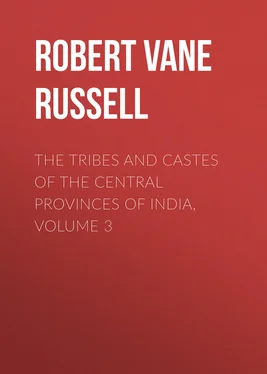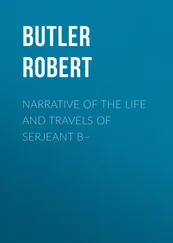Robert Vane Russell - The Tribes and Castes of the Central Provinces of India, Volume 3
Здесь есть возможность читать онлайн «Robert Vane Russell - The Tribes and Castes of the Central Provinces of India, Volume 3» — ознакомительный отрывок электронной книги совершенно бесплатно, а после прочтения отрывка купить полную версию. В некоторых случаях можно слушать аудио, скачать через торрент в формате fb2 и присутствует краткое содержание. Жанр: foreign_prose, История, foreign_edu, foreign_antique, на английском языке. Описание произведения, (предисловие) а так же отзывы посетителей доступны на портале библиотеки ЛибКат.
- Название:The Tribes and Castes of the Central Provinces of India, Volume 3
- Автор:
- Жанр:
- Год:неизвестен
- ISBN:нет данных
- Рейтинг книги:5 / 5. Голосов: 1
-
Избранное:Добавить в избранное
- Отзывы:
-
Ваша оценка:
- 100
- 1
- 2
- 3
- 4
- 5
The Tribes and Castes of the Central Provinces of India, Volume 3: краткое содержание, описание и аннотация
Предлагаем к чтению аннотацию, описание, краткое содержание или предисловие (зависит от того, что написал сам автор книги «The Tribes and Castes of the Central Provinces of India, Volume 3»). Если вы не нашли необходимую информацию о книге — напишите в комментариях, мы постараемся отыскать её.
The Tribes and Castes of the Central Provinces of India, Volume 3 — читать онлайн ознакомительный отрывок
Ниже представлен текст книги, разбитый по страницам. Система сохранения места последней прочитанной страницы, позволяет с удобством читать онлайн бесплатно книгу «The Tribes and Castes of the Central Provinces of India, Volume 3», без необходимости каждый раз заново искать на чём Вы остановились. Поставьте закладку, и сможете в любой момент перейти на страницу, на которой закончили чтение.
Интервал:
Закладка:
Their marriage ceremony consists merely in the placing of bangles on the woman’s wrists, which is the form by which a widow is married among other castes. If a widow marries a man other than her husband’s younger brother, the new husband must pay twelve rupees to her first husband’s family, or to her parents if she has returned to them. If she takes with her a child born of her first husband with permission to keep it, the second husband must pay eight rupees to the first husband’s family as the price of the child. But if the child is to be returned as soon as it is able to shift for itself the second husband receives eight rupees instead of paying it, as remuneration for his trouble in rearing the baby. The caste bury their dead with the feet to the south, like the Hindus. The principal business of the Gaurias is to catch and exhibit snakes, and they carry a damru or rattle in the shape of an hour-glass, which is considered to be a distinctive badge of the caste. If a Gauria saw an Ojha snake-charmer carrying a damru he would consider himself entitled to take it from the Ojha forcibly if he could. A Gauria is forbidden to exhibit monkeys under penalty of being put out of caste. Their principal festival is the Nāg-Panchmi, when the cobra is worshipped. They also profess to know charms for curing persons bitten by snakes. The following incantation is cried by a Gauria snake-doctor three times into the ears of his patient in a loud voice:
“The bel tree and the bel leaves are on the other side of the river. All the Gaurias are drowned in it. The breast of the koil ; over it is a net. Eight snakes went to the forest. They tamed rats on the green tree. The snakes are flying, causing the parrots to fly. They want to play, but who can make them play? After finishing their play they stood up; arise thou also, thou sword. I am waking you (the patient) up by crying in your ear, I conjure you by the name of Dhanvantari 22 22 The Celestial Physician.
to rise carefully.”
Similar meaningless charms are employed for curing the bites of scorpions and for exorcising bad spirits and the influence of the evil eye.
The Gaurias will eat almost all kinds of flesh, including pigs, rats, fowls and jackals, but they abstain from beef. Their social status is so low that practically no caste will take food or water from them, but they are not considered as impure. They are great drunkards, and are easily known by their damrus or rattles and the baskets in which they carry their snakes.
Ghasia
1. Description of the caste
Ghasia, Sais. 23 23 This article is compiled partly from papers by Munshis Pyāre Lāl Misra and Kanhya Lāl of the Gazetteer Office.
—A low Dravidian caste of Orissa and Central India who cut grass, tend horses and act as village musicians at festivals. In the Central Provinces they numbered 43,000 in 1911, residing principally in the Chhattīsgarh Division and the adjoining Feudatory States. The word Ghasia is derived from ghās (grass) and means a grass-cutter. Sir H. Risley states that they are a fishing and cultivating caste of Chota Nāgpur and Central India, who attend as musicians at weddings and festivals and also perform menial offices of all kinds. 24 24 Tribes and Castes of Bengal , art. Ghāsi.
In Bastar they are described as an inferior caste who serve as horse-keepers and also make and mend brass vessels. They dress like the Māria Gonds and subsist partly by cultivation and partly by labour. 25 25 Central Provinces Gazetteer (1871), p. 273.
Dr. Ball describes them in Singhbhūm as gold-washers and musicians. Colonel Dalton speaks of them as “An extraordinary tribe, foul parasites of the Central Indian hill tribes and submitting to be degraded even by them. If the Chandāls of the Purānas, though descended from the union of a Brāhmini and a Sūdra, are the lowest of the low, the Ghasias are Chandāls and the people further south who are called Pariahs are no doubt of the same distinguished lineage.” 26 26 Descriptive Ethnology of Bengal , p. 325.
2. Subcastes
The Ghasias generally, however, appear now to be a harmless caste of labourers without any specially degrading or repulsive traits. In Mandla their social position and customs are much on a par with those of the Gonds, from whom a considerable section of the caste seems to be derived. In other localities they have probably immigrated into the Central Provinces from Bundelkhand and Orissa. Among their subdivisions the following may be mentioned: the Udia, who cure raw hides and do the work of sweepers and are generally looked down on; the Dingkuchia, who castrate cattle and ponies; the Dolboha, who carry dhoolies or palanquins; the Nagārchi, who derive their name from the nakkāra or kettle-drum and are village musicians; the Khaltaha or those from Raipur; the Laria, belonging to Chhattīsgarh, and the Uria of the Uriya country; the Rāmgarhia, who take their name from Rāmgarh in the Mandla District, and the Mahobia from Mahoba in Bundelkhand. Those members of the caste who work as grooms have become a separate group and call themselves Sais, dropping the name of Ghasia. They rank higher than the others and marry among themselves, and some of them have become cultivators or work as village watchmen. They are also called Thānwar by the Gonds, the word meaning stable or stall. In Chota Nāgpur a number of Ghasias have become tailors and are tending to form a separate subcaste under the name of Darzi.
3. Exogamous sections
Their septs are of the usual low-caste type, being named after animals, inanimate objects or nicknames of ancestors. One of them is Pānch-biha or ‘He who had five wives,’ and another Kul-dīp or ‘The sept of the lamp.’ Members of this sept will stop eating if a lamp goes out. The Janta Ragda take their name from the mill for grinding corn and will not have a grinding-mill in their houses. They say that a female ancestor was delivered of a child when sitting near a grinding-mill and this gave the sept its name. Three septs are named after other castes: Kumhārbans, descended from a potter; Gāndbans, from a Gānda; and Luha, from a Lohār or blacksmith, and which names indicate that members of these castes have been admitted into the community.
4. Marriage
Marriage is forbidden within the sept, but is permitted between the children of brothers and sisters. Those members of the caste who have become Kabīrpanthis may also marry with the others. Marriages may be infant or adult. A girl who is seduced by a member of the caste is married to him by a simple ceremony, the couple standing before a twig of the ūmar 27 27 Ficus glomerata.
tree, while some women sprinkle turmeric over them. If a girl goes wrong with an outsider she is permanently expelled and a feast is exacted from her parents. The boy and his relatives go to the girl’s house for the betrothal, and a present of various articles of food and dress is made to her family, apparently as a sort of repayment for their expenditure in feeding and clothing her. A gift of clothes is also made to her mother, called dudh-sāri , and is regarded as the price of the milk with which the mother nourished the girl in her infancy. A goat, which forms part of the bride-price, is killed and eaten by the parties and their relatives. The binding portion of the marriage is the bhānwar ceremony, at which the couple walk seven times round the marriage-post, holding each other by the little fingers. When they return to the bridegroom’s house, a cock or a goat is killed and the head buried before the door; the foreheads of the couple are marked with its blood and they go inside the house. If the bride is not adult, she goes home after a stay of two days, and the gauna or going-away ceremony is performed when she finally leaves her parents’ house. The remarriage of widows is permitted, no restriction being imposed on the widow in her choice of a second husband. Divorce is permitted for infidelity on the part of the wife.
Интервал:
Закладка:
Похожие книги на «The Tribes and Castes of the Central Provinces of India, Volume 3»
Представляем Вашему вниманию похожие книги на «The Tribes and Castes of the Central Provinces of India, Volume 3» списком для выбора. Мы отобрали схожую по названию и смыслу литературу в надежде предоставить читателям больше вариантов отыскать новые, интересные, ещё непрочитанные произведения.
Обсуждение, отзывы о книге «The Tribes and Castes of the Central Provinces of India, Volume 3» и просто собственные мнения читателей. Оставьте ваши комментарии, напишите, что Вы думаете о произведении, его смысле или главных героях. Укажите что конкретно понравилось, а что нет, и почему Вы так считаете.












